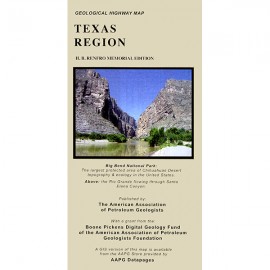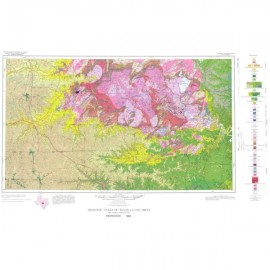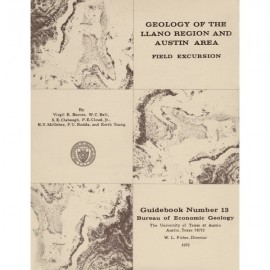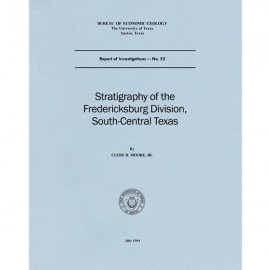Miscellaneous Maps, Charts & Sections
-
Books & Reports
- Reports of Investigations
- Guidebooks
- Udden Series
- Geological Circulars
- Down To Earth
- Atlases of Major Oil and Gas Reservoirs
- Texas Memorial Museum Publications
- Environmental Geologic Atlas of the Texas Coastal Zone
- Mineral Resource Circulars
- Other Reports
- Seminars and Workshops
- Handbooks
- Submerged Lands of Texas
- Symposia
- Annual Reports
- Open File Reports
-
Maps & Cross Sections
- Thematic Maps
- Miscellaneous Maps, Charts & Sections
- Geologic Atlas of Texas
- STATEMAP Project Maps
- Geologic Quadrangle Maps
- Cross Sections
- Highway Geology Map
- Energy and Mineral Resource Maps
- Shoreline Change and Other Posters
- Wilcox Group, East Texas, Geological / Hydrological Folios
- Bouguer Gravity Atlas of Texas
- River Basin Regional Studies
- Featured Maps
- Posters
- Teachers & the Public
-
Geological Society Publications
- Gulf Coast Association of Geological Societies
- Alabama Geological Society
- Austin Geological Society
- Corpus Christi Geological Society
- Houston Geological Society
- Lafayette Geological Society
- Mississippi Geological Society
- New Orleans Geological Society
- South Texas Geological Society
- GCS SEPM Publications
- Historic BEG & UT Series
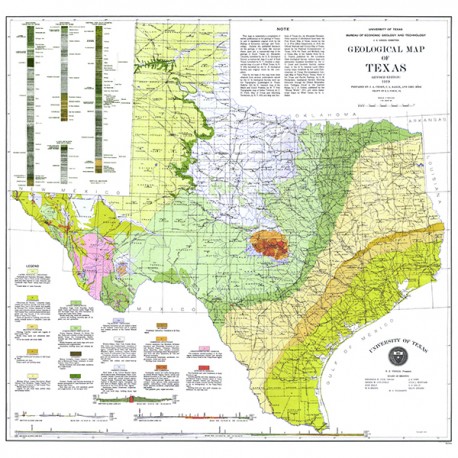
Geologic Map of Texas, 1916
HMAP014
Geology of Texas Map, 1916, by J. A. Udden, C. L. Baker, and Emil Böse, Scale 1:1,500,000. Approx. 33in x 33in. Print
When this Geological Map of Texas was published in 1916, the country was in the midst of World War I. The Bureau of Economic Geology was just 7 years old, and Dr. J. A. Udden, a highly regarded professor and geologist, had recently become the second Director of the Bureau of Economic Geology. Early oil discoveries had been made near Corsicana in 1894, at Spindletop on the Gulf Coast in 1901, and in north-central Texas, but the giant East Texas oil field and oil fields of the Permian Basin were yet to be discovered.
Dr. Udden and his coauthors compiled this map using their own work and that of others, beginning with the work of Dr. Ferdinand Roemer, a German geologist who first studied the geology of central Texas in 1845. This Geological Map of Texas was published with a report titled Review of the Geology of Texas, which was "an effort to give a brief, systematic account of the main facts ascertained relative to the rocks in Texas, and their economic, tectonic, and historic relations." At the time of his compilation, Udden reported that only about 1/25 of the state had been "fairly satisfactorily mapped," mostly by geologists from the U.S. Geological Survey or the Bureau. The geology of most of Texas was known only from regional surveys or reconnaissance mapping.
It is remarkable how much these early field geologists were able to decipher. They had few of the tools we now think of as essential. No aerial photographs and few detailed topographic maps were available, and transportation was difficult, but most of the major elements of Texas geology are clearly depicted. Subsurface interpretations, shown on the cross sections, were based on surface outcrops and a very few deep boreholes.
In succeeding decades, new geologic concepts, the application of new technologies, such as geophysics, and new knowledge derived from the exploration for hydrocarbon, water, and mineral resources, as well as from the study of natural processes, have added immeasurably to our understanding of the "economic, tectonic, and historic relations" of the geology of Texas. The basic framework described by Udden and his coauthors has not changed, and Dr. Udden's prophesy has been fulfilled: there has been "interesting geologic work to do in Texas for a whole century to come."
Citation:
Udden, J. A., Baker, C. L.., and Böse, Emil, 1916, Map from Review of the Geology of Texas: University of Texas, Austin, Bureau of Economic Geology and Technology, Bulletin 44.

